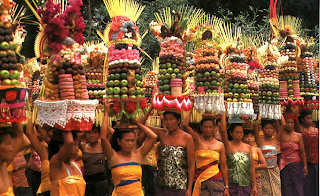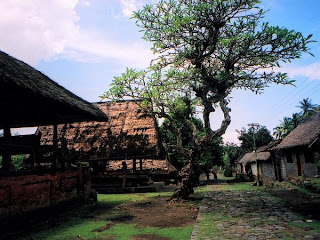intending to do some trekking stay in the villages around the shores of Danau Batur, and plan an early start to climb the volcano.
Even day-trippers should bring some sort of wrap in case the mist closes in and
it hits 18°C.
Orientation
The villages around the Gunung Batur crater rim have grown together in a continuous, untidy strip. The main village is Kintamani though the whole area is often referred to by that name. Coming from the south, the first
village is Penelokan, where tour groups stop to gasp at the view, eat a buffet lunch and be hassled by souvenir-sellers. Penelokan is also where you can take a short road down into the crater. From here, a road loosely follows the shore of Danau Batur, linking the villages of Kedisan and Toya Bungkah. You can travel between the Gunung Batur and Danau Bratan areas using
a beautiful mountain lane
 This very important Hindu-Buddhist temple was founded in the 17th century. It is dedicated to Dewi Danu, the goddess of the waters, and is actually built on small islands, which means it is completely surrounded by the lake. Both pilgrimages and ceremonies are held here to ensure that there is a supply of water for farmers all over Bali.
This very important Hindu-Buddhist temple was founded in the 17th century. It is dedicated to Dewi Danu, the goddess of the waters, and is actually built on small islands, which means it is completely surrounded by the lake. Both pilgrimages and ceremonies are held here to ensure that there is a supply of water for farmers all over Bali.
The temple is truly beautiful, with classical Hindu thatch-roofed meru (multiroofed shrines) reflected in the water and silhouetted against the often cloudy mountain backdrop - one of the most common photographic images of Bali.
A large banyan tree shades the entrance; walk through manicured gardens and past an impressive Buddhist stupa to reach the lakeside.
For an almost surreal experience, take a quiet paddle across the lake and see Ulun Danu Bratan Temple at sunrise - arrange it with a boatman the night before.
The Perama Ulun danu eating house in the grounds has a pleasant outdoor terrace and the usual Indonesian and Western dishes.

Bali got a wave of publicity in 2006 when the world record for the most surfers to ride a single wave was set at kuta beach, fifty-three people from around the world shared the moment.
If that news highlighted Bali as an incredible surf destination, it was but one of many super-lative stories that could have been written. Jaded travellers the world over arrive in Bali and have their world-weary ways stripped away by the place that invented the word "unique"
Many try to pigeon-hole Bali as a cliche, but look a little deeper and you'll find a pervasive culture and beauty. Tiny offerings, with their brilliant bits of fresh flowers found in even the tiniest of niches, dance perfomances, magical with their grace and charm. Lyrical local music playing live in even the most obscure corners.
Balinese culture is no after-thought overlay, shucked on by only a few it is a fundamental part of everyday life and it intrigues and entrances everyone who visits.

The beauty is a part of this cliche, but what can you do? Wild beaches stretching off to the horizon, rice terraces increadibly green and sinuous in their beauty, lush tropical forests where your biggest worry is a ripe fruit hitting your head.
And these are just some of the images you'll savour.
And then there are the people. A cliche you're unlikely to find a more joyous and delightful people anywhere! Travel here is just so easy. Whether in the resorts of the tourist areas or the remote corners of Bali, you'll find it a breeze to catch your own personal wave here, no matter what form it may take.
To get started for Bali, all you really need is a ticket. (well maybe also a visa,passport, some money, but you get the idea.) The entire island is just so well set up for visitors, the Balinese are so welcoming and the climate and weather are so agreeable that you really can just hop on a plane and go.
If bali reward the spontaneous traveller, they also reward the traveller who plans. in bali especially, you can stay at exquisite place, experience unique aspects of the culture and tailor your trip to a remakable degree with advance work.
If you want to make time for real discoveries or just discover some good bargains, you can reap the rewards of forethought.
Whatever your travel style, you'll find the real obstacles to independent travel in this part of the world are few.
The islands are used to travellers of all stripes, English is widely spoken and the people truly live up to the shop worn cliche of friendly.

The best time to visit Bali, in terms of the weather, is during the dry season(april to septemper). The rest of the year is more humid, cloudier and has more rainstorms, but you can still enjoy a holiday.
There are also distinct tourist seasons that affect the picture.
The European, American and Japanese summer holidays bring the biggest crowds-july, august and early september are busy.
Accommodation can be very tight in these months and prices are higher. Many Australians, arrive between Christmas and early january, when airfares to and from Australia are higher and flights can be booked solid.
The school holidays in early April, late june to early july and late september also see more Australians, most of them on package tours to resort areas in southern Bali.
Many Indonesians visit Bali around the end of December and during some Indonesian holidays. Outside these times Bali has surprisingly few tourists and there are empty rooms and restaurants everywhere. Balinese festivals, holidays and special celebrations occur all the time, and most of them are not scheduled according to western calendars, so don't worry too much about timing your visit to coincide with local events.
In Bali, you can spend as much you want- there are fabulous resorts where a room costs US$500 or more a night, where dinner costs more than US$75 per person and you can be reborn in spa for US$100 an hour. at the other extreme, you can find decent budget rooms easily for 100,000Rp. and enjoy a fresh meal from a warung(food stall) for Under 20,000Rp. In short, Bali is a bargain for budget travellers and offers excellent value for those seeking every luxury.
In General, travellers who don't want air-con and hot water will discover they can get good rooms almost anywhere in Bali for under US$20, You can have an excellent three-course meal for US$12,(including a large bottle of beer) at many restaurants, while US$30 can get you a gourment delight at some of the finest restaurants around.
Transport is affordable- remember that Bali is a small island. Public minibuses, buses and bemo(small minibuses) are the local form of public transfort and they're very cheap- 50,000Rp will get you a cross the island. A rental motorcycle costs around US$10 or more per day, and a small jeep runs about US$20 per day. You can charter a car and a driver for around US$25 to US$50 per day.
Nearly every museum, major temple or tourist site has an entry charge of about 10,000Rp/5000Rp per adult/child,- it's a trifling amount. Galleries, bars and clubs are almost always free and the only place you'll really have to pay a premium is at a few attractions aimed at visitors such as animal parks, and adventure activities like river-rafting or water sport.
Overall, it's possible to live a simple life for under US$10 a day. This gets you cheap room in Kuta, three solid meals at warung, one or more cold beers and all the free surfing you want on the beach. Spend more, say US$50 a day and you'll pretty much be able eat, drink or do anything you want while enjoying a great midpriced room. Bali really are that cheap.

You see signs by the side of the road as you drive around Bali that read "Bakso Babi". An innocent-sounding little pharase but one that shows a sea change of attitudes on the island. No, it's not a nascent Balinese political party or a powerful independence slogan or even a cheer for a beloved local leader, rather it's a sign advertising pork meatballs, but in Bali such seemingly simple things are fraught with meaning - those little meatballs sold from carts trolling through neighbourhoods or waiting for peckish drivers are usually made from chicken or beef, meats that go down well with people of any religious faith, especially muslims from the rest of indonesia.

Certainly the Balinese (90% practise their own fascinating version of Hinduism) have always loved pork. Just look at the babi guling joints all over the island where you can get the succulent and richly seasoned roasted young pork. But a vendor putting 'Bakso Babi' on his cart has found a subtle but clear-cut way of saying I'm Balinese, I'm not from java. And the Balinese are there munching away in support.
Called "Krama Bali", loosely "Bali for the Balinese", the recent uptick in declarations of a more aggressive Balinese identity are notable.
The Balinese normally prize a form of modesty and restraint that some mistake for politeness verging on meekness. so when they say to the rest of indonesia 'you can't eat our meatballs' there's a lot more to it than what gets sold by the side of the road. Although it remains a remarkably tolerant society - there is no reported religious strife on the island - The Balinese can't help but feel threatened by forces in the rest of indonesia.






